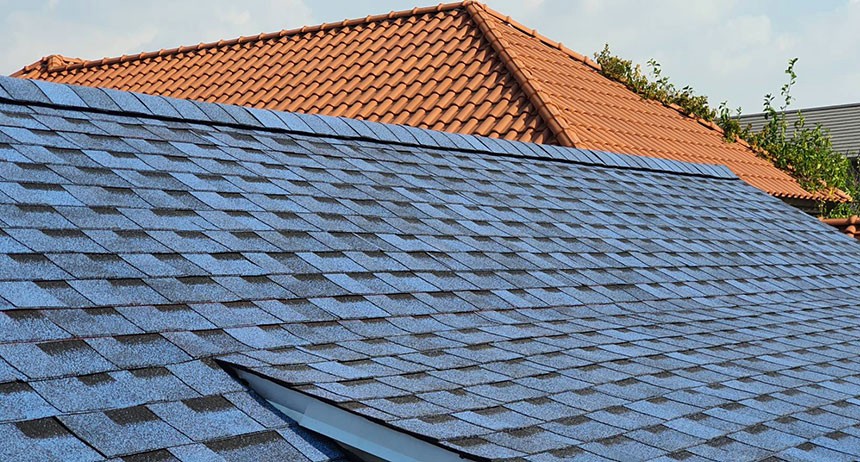A roof is more than just a passive element that protects the walls and the house from adverse climatic conditions. It also creates additional opportunities for decorating inside and accentuating the exterior of the building. Clay roof tiles and asphalt shingles are the most popular roofing materials. They both have advantages, but which one is suitable for your home? Let’s find out.
Clay Roof Tiles vs. Asphalt Shingles
Clay tiles are made from natural clay fired in a kiln at high temperatures, creating a durable tile that lasts for decades. The beauty of clay tiles is that they come in various colors, styles and shapes. They can even be painted to match your trim color or left natural for an aged look. Asphalt shingles are made from petroleum-based materials such as coal tar and petrochemicals. These shingles are very affordable but also tend to need replacing more often than other types of roofs. However, they come in many different colors and styles, so they can be customized to fit your home’s personality perfectly!
Durability
Clay roof tiles can last up to 60 years, while asphalt shingles only last 20-30 years. The main reason for this is that clay roof tiles are thicker and stronger than asphalt shingles, which can only be expected to last two or three decades. Asphalt shingles are made from petroleum products and are not designed to withstand heavy weather conditions or temperature changes. This means they may crack or split when exposed to extreme heat or cold. On the other hand, clay roof tiles have natural insulating properties that allow them to withstand extreme temperatures without cracking or splitting apart as asphalt shingles would under similar conditions. Another reason why clay roof tiles are more durable than asphalt shingles is that they do not absorb water as asphalt shingles do. Asphalt absorbs moisture which causes it to become heavier and more susceptible to damage from wind and rain storms.
Appearance
Clay roof tiles come in many different styles and sizes, so you can get precisely what you want for your home. For example, some clay roof tiles feature intricate designs that make them look like slate or wood shake, while others are simple squares or rectangles without embellishments. Some clay roof tile manufacturers even offer custom patterns that allow you to choose which designs go where on your home’s roofline, so they look cohesive when viewed from ground level. Asphalt shingles come in many different colors and styles, including those that resemble slate or ceramic tile. They’re inexpensive but won’t last as long as clay roofs.
Cost
The cost of clay roof tiles depends on the quality of the tiles you buy and where you live. Asphalt shingles are much less variable. Because clay roofs last longer than asphalt shingles, they may save you money by keeping your home cooler in the summer and warmer in the winter — because of their ability to reflect heat — thus reducing your energy bills over time.
While clay tile roofs are more expensive than asphalt shingles, they are long-lasting and resistant to fire and weather. They also offer superior insulation, decrease noise levels in the house, and can be used with several roofs such as flat, sloped and mansards. Clay tiles may crack when subjected to temperature changes, but this usually happens only in areas where temperatures exceed 85 degrees.
Installation
Installing a clay tile roof is a complicated procedure due to the nature of the installation process. First, the tiles are attached in accordance with local regulations and manufacturer’s requirements, which may differ based on the tile type, shape, wind loads, and slope of the building. Asphalt shingles are lightweight, supplied in bundles, and come pre-cut, so they are easy to stack together. They can be installed during any season and require little maintenance beyond yearly inspections to ensure there are no missing or damaged shingles.
Maintenance
Clay roof tiles have a longer lifespan than asphalt shingles, so maintenance is less frequent. Clay roofs are durable and reliable, but they need to be maintained to last as long as possible. Sealing your clay roof at least once every three years will protect your roof from UV rays and moisture penetration, which can cause damage that won’t show up immediately. Sealing also helps protect tile colors from fading, so you don’t have to worry about your roof looking dull or drab over time. With asphalt shingles, all you have to do is keep them clean by raking off any debris that has accumulated on top of them. Because asphalt shingles are less fragile than clay, the roof over your head is more likely to stay intact. You can fix any problems that arise without calling in a pro.
The Bottom Line
Choosing between clay roof tiles and asphalt shingles can be a difficult decision. While both have advantages, evaluating your needs and comparing them to each product’s pros and cons is essential. Tata Aashiyana is here to help you make the best choice. We offer a wide selection of high-quality roofing products, including clay roof tiles and asphalt shingles. Our team is dedicated to providing the best roofing materials and installation services for residential roofs of all shapes and sizes. When investing in your home, go to Tata Aashiyana—your trusted partner for solid investments!





